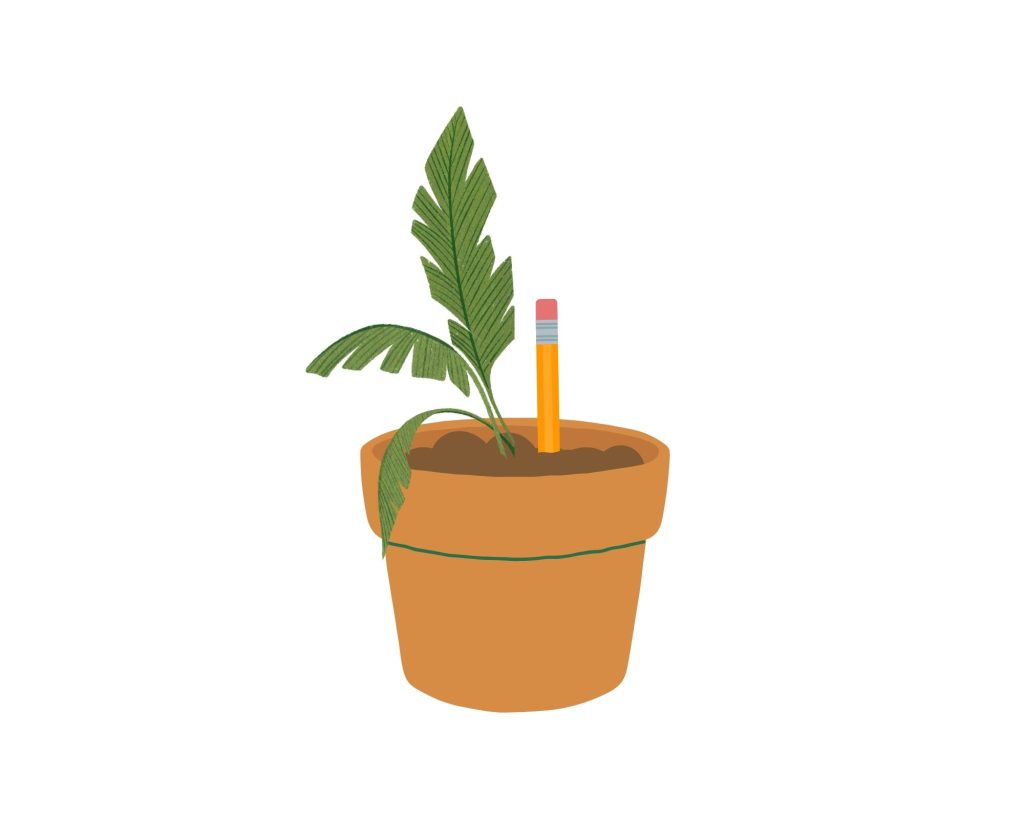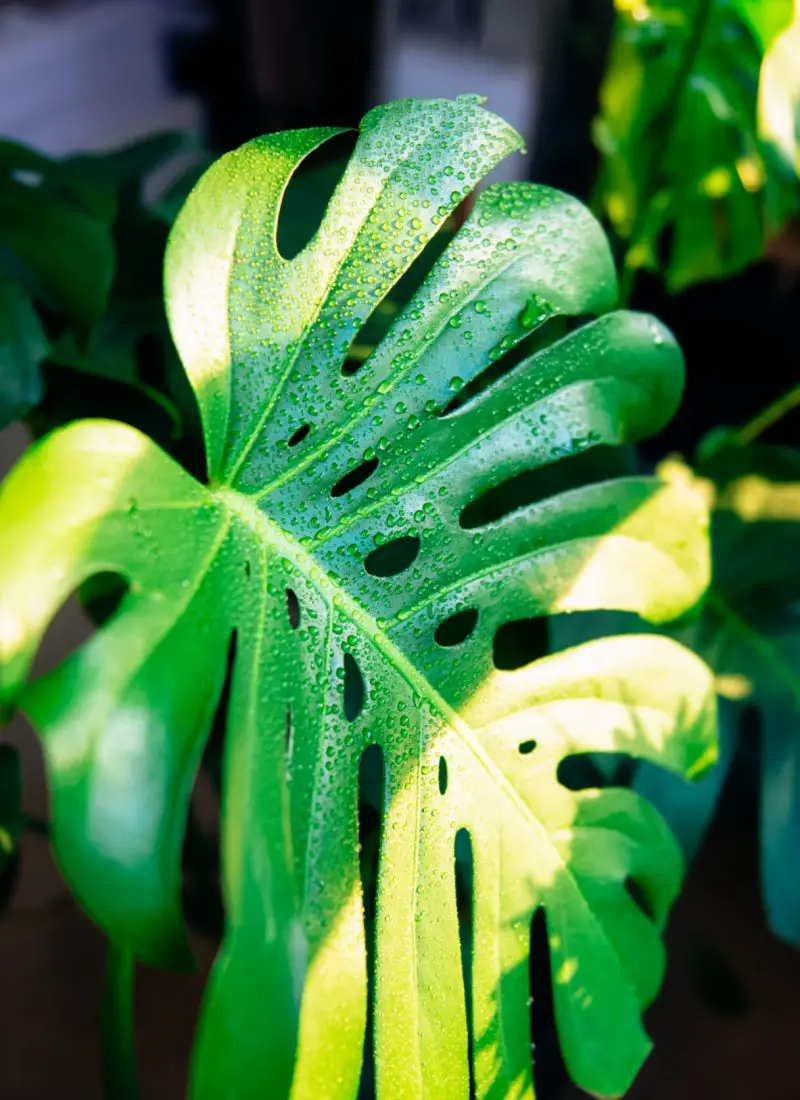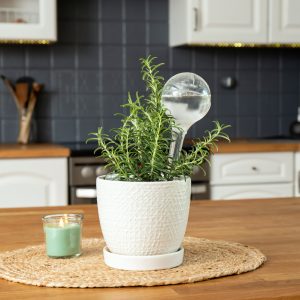
Watering stakes are nothing new but they are one of the tools that could make your indoor plant care as easy as pie. There are also hybrids of it with watering bulbs to make watering your plants both easy and fitting to your aesthetic. But how do watering stakes work, exactly?
Watering stakes for indoor plants are often made of terracotta. The porous clay material provides a slow stream of water from a reservoir, i.e., a clean recycled bottle, fitted to the stake, and inserted into the soil. This set-up is ideal for plants that thrive in a constantly damp environment.
Below, I elaborate more on the concept of watering stakes, its different types, and common questions people have about it:
(As an Amazon Associate, I earn from qualifying purchases.)
How to use watering stakes?
Most watering stakes can be set up the same way, but be sure to read the instructions given as some may have more specific instructions. Here’s how you can prepare yours:

1. Soak the watering stakes in water overnight. This is usually needed for terracotta and unglazed ceramic-made ones to ensure water flows easily from the porous clay. For plastic-made ones, you can skip this step. Note on watering stakes: Try to buy multiple sizes to fit different-sized bottles as stated in the next step.
2. Select a plastic bottle that can fit over the stake’s opening. This is your plant’s water reservoir so it’s important to choose a decently-sized one. It’s a bit of trial and error, so don’t worry if the bottles you have don’t fit the stakes. You can use other bottle types, like wine or glass bottles, but keep in mind that the weight will be putting pressure on the stake. Over time, it may break or topple over so be careful.

Note: Some watering stakes have coiled tubings that can be connected to an external reservoir. These have their own sets of instructions, with a concept somewhat similar to a wicking system. So to prevent any confusion, I will not be discussing this type of watering stake.

3. Water the plant thoroughly before placing the watering stake in. If the soil is too dry beforehand, the entire reservoir will empty into the plant overnight, if not immediately.
4. Make a hole in the plant’s soil near the center, similarly-sized to the stake’s length and width. The idea here is you don’t want to forcibly push the stake in, and accidentally damage it. Even small cracks are enough to make the item overwater your plant, instead of the intended slow dripping.


5. Insert the watering stake into the prepared hole, keeping it vertically straight and not angled. Leaks are common when the stake is tilted, and there’s also a higher chance of the bottle reservoir tipping over. So keep it pointing down as best as you can, and compress the soil gently around it to secure it.
6. Fill the plastic bottle reservoir with water. You can use filtered or rainwater for this. Tap water in some regions may contain chemicals in it which can accumulate as deposits in the watering stakes over time. But if you know for a fact that your tap water is fine, then feel free to use that instead!


7. Place the plastic bottle into the watering stake upside down. This may need some tries as you want to ensure it’ll be placed snugly into the stake. Which is why the 2nd step above is important so you know it’s the right-sized bottle for the stake.
8. Observe the reservoir and the plant’s saucer over a few days. If there’s less water in the reservoir and too much in the saucer in less than 2-3 days, that means the plant is being overwatered. You may need to examine the watering stake to ensure there’s no damage and try to set-it up again.
Types of Watering Stakes
Watering stakes are an effective tool for maintaining the moisture levels of indoor plants. They come in various types, each designed to cater to different plant needs and environments. Here are some of the most common types:
For Potted Plants
There are 3 types of watering stakes you can use for your potted plants:

This particular product from Amazon has some great 2,427 ratings with 4.4 stars, and for good reason too! It’s very easy to use and works well to seep water slowly into the plant’s roots (thanks to its porous clay material) over a number of days. However, it’s not ideal for small plants either because a typical watering stake/spike is about 6.8 inches long.
Another issue is that this can only be placed in one plant at a time. So it’s not suitable for those with a huge collection of plants (like Nick, who has 100+ plants in his apartment alone). In those cases, using the following watering stake will be more helpful.

This popular product from Amazon has an insane 7,099 ratings with a whopping 4.3 stars. Now, a lot of people have been raving about this item for quite some time now. And generally, it comes down to the fact that not only does it work just like your regular terracotta watering spike, it uses the concept of wicking (more on that in our wicking article here) to siphon water from an external reservoir.
Ok, smarty pants, what exactly does that mean? These stakes have a thin tubing that’s connected to the cap secured on the watering stake. When you uncoil the tubing and place it in a bowl of water, the vacuum in the cap causes water to be sucked in through the tubing and drip into the stake. If you place the water bowl at a higher level, this will cause more water to flow in (because it can’t defy gravity no matter what Elphaba says). But if it’s lower, then you have a slower flow rate which is perfect for those going on a long vacation. Bonus: you can water multiple plants by connecting them all to a shared vat of water. Neat, huh?

This hybrid product from Etsy combines the best of a watering globe and a watering stake into one. By keeping the terracotta watering spike as is, it comes with a watering globe which can be easily fitted into the stake. Did I also mention you can easily refill the bulb from the top without taking it off the stake? Talk about making your life easy with something as accessible and gorgeous as these guys!
For Outdoor Plants/Trees

You can actually use the Terracotta watering stakes as I’ve mentioned on outdoor plants, if you have a small garden. The only thing you’d have to ensure is placing each stake strategically next to each plant to ensure their best growth. Otherwise, you may benefit more from using a drip irrigation system instead, which I talked about more in detail here.
Now, with regards to trees, you may have heard about ‘Deep Drip Watering Stakes’. I can assure you this is not similar to the watering stakes or spikes I’ve been discussing so far in this article. Instead, imagine a relatively large and long stake that Buffy would love to have in her arsenal against the vampires. Across its length, there are multiple holes where water will seep out. You bury it in the ground near the base of your tree, then uncap the top of the stake, place your long hose or drip irrigation tubing in it, and voila!
What’s good about this is that it will encourage roots to grow deeper into the soil, rather than close to the surface because water is being delivered underground. Even though it’s not that closely related to our topic at hand, I thought it’d be a fascinating point to bring up. And if you’re interested in looking into one, I find that this Deep Drip Irrigation Stake for Trees from Amazon is a good bet. It’s got a solid 465 ratings, and 4.5 stars!
DIY Watering Stakes
Now, we are not exactly going to make stakes at home to make this work. Instead, we’re going to take the concept of watering stakes and create an olla-type thing to water your plants. But the downside to this is that it’s not suitable for small to medium-sized plants, because it needs enough space for you to bury the “stake”/olla underground near the plant’s roots. It’s also best used in gardens for in-ground planting.
So here’s how you can make your DIY watering “stakes” ala olla:

1. Gather several empty 250mL, 500mL, 1L plastic bottles with caps. The larger the volume size of the bottles, the longer the plants will be watered. So choose accordingly depending on your plant’s water needs and size.
2. Clean the bottles thoroughly, removing any labels or stickers. This is mostly just to wash off any excess liquid in the bottle before you start using them.


3. Dig a hole the size of the bottle into the plant’s soil. You need to ensure the hole will fit the entire bottle up to its neck, keeping the opening above the surface. Also, be careful not to destroy any roots in the process.
4. Poke/drill several tiny holes around the bottle, from top to bottom. Water will release slowly through these holes, directly to the plant’s surrounding roots. But be conscious about the number of holes you poke, as more holes equals more water seeping out.


5. Place the bottle inside the plant’s soil, with the opening visible on the surface. This way, you can easily fill in the water without removing the bottle from the pot.
6. Fill the bottle full with water and seal it with its cap. Only use filtered or rainwater for this. Tap water usually leaves behind white residue, which is a sign of high mineral content in the water. You can read our article on tap water and rainwater here if you’re interested in finding out more.

7. Refill the bottle with more water when it lessens. Use a wooden or bamboo chopstick to check where the water level is by placing it inside the bottle. If it’s about ¾ empty, it’s time to top up the water again.
Frequently Asked Questions About Watering Stakes for Indoor Plants:

Are self-watering stakes good for indoor plants?
Self-watering stakes are good and beneficial for indoor plants. They provide a consistent supply of water, reducing the risk of overwatering or underwatering. However, they may not be suitable for all types of plants, particularly those that prefer dry conditions.
How well do plant watering stakes work?
Plant watering stakes are effective in keeping a plant’s soil consistently moist. Water is released slowly and directly into the soil, reducing evaporation and runoff. However, their efficiency can vary based on factors like soil type, plant needs, and stake quality.
How do you water indoor plants while on vacation?
There are 4 ways you can water your indoor plants while you’re on vacation, provided you’ve water your plants thoroughly before leaving:
- Creating a drip irrigation system.
- Setting up a wicking watering system.
- Using watering globes.
- Using watering stakes.
If all else fails or you’d rather not be bothered, you can always ask a friend/neighbor/plant sitter to water your plants while you’re away.

What type of water to use for indoor plants?
Use room-temperature distilled, filtered or rainwater for indoor plants. These types of water are free from chemicals found in tap water, like chlorine, which can accumulate in the plant’s soil. You can read more about using tap water in plants in this article here.
What time is best to water potted plants?
Early morning or late afternoon is the best time to water potted plants. The temperature is cooler, reducing water evaporation and allows plants to absorb water effectively before/after the heat of the day. If you want to know more about it, I’ve discussed the worst time to water plants in detail in this article.
How often should I be watering my indoor plants?
Water indoor plants on a weekly basis when the top 1-2 inches of soil is dry. However, this may vary depending on the plant type, pot size, and its environment. For example, most plants need watering once a week but succulents can go about 2 weeks or more without water. So be mindful of your plants’ water needs to prevent overwatering.
Disclaimer: The sources used for this article are from forums where people relate their firsthand experiences of using watering stakes. At present, there unfortunately doesn’t seem to be any articles from reputable sites discussing the pros and cons of these items. But if you’re ever used one, feel free to tell us all about it down in the comments 😀
References:
- Accomplished-Pea2965. (2023, January 29). Anyone use self watering stakes? Any tips or advice [Online forum post]. Reddit. https://www.reddit.com/r/houseplants/comments/sfmnt2/anyone_use_self_watering_stakes_any_tips_or_advice/
- [deleted]. (2018, October 31). Just bought hydro spikes – Any tips? [Online forum post]. Reddit. https://www.reddit.com/r/houseplants/comments/9su8r2/just_bought_hydro_spikes_any_tips/
- Garden.org. (2018, June 6). Terracotta Watering Spikes [Online forum post]. https://garden.org/thread/view/81024/Terracotta-Watering-Spikes/
- Reddit User. (2019, May 12). Using ceramic watering spikes for indoor plants [Online forum post]. Reddit. https://www.reddit.com/r/gardening/comments/bknrvf/using_ceramic_watering_spikes_for_indoor_plants/
- Reddit User. (2019, June 11). Watering spikes for vacations outdoor tomato [Online forum post]. Reddit. https://www.reddit.com/r/gardening/comments/bzbcgp/watering_spikes_for_vacations_outdoor_tomato/
- Reddit User. (2021, January 23). Watering stakes [Online forum post]. Reddit. https://www.reddit.com/r/houseplants/comments/k2572z/watering_stakes/
- Reddit User. (2021, January 23). Watering spikes – Has anyone used these? Are they any good? [Online forum post]. Reddit. https://www.reddit.com/r/houseplants/comments/l3cr3k/watering_spikes_has_anyone_used_these_are_they/
- Reddit User. (2022, July 6). Self-watering spikes help [Online forum post]. Reddit. https://www.reddit.com/r/houseplants/comments/w6knmt/selfwatering_spikes_help/





